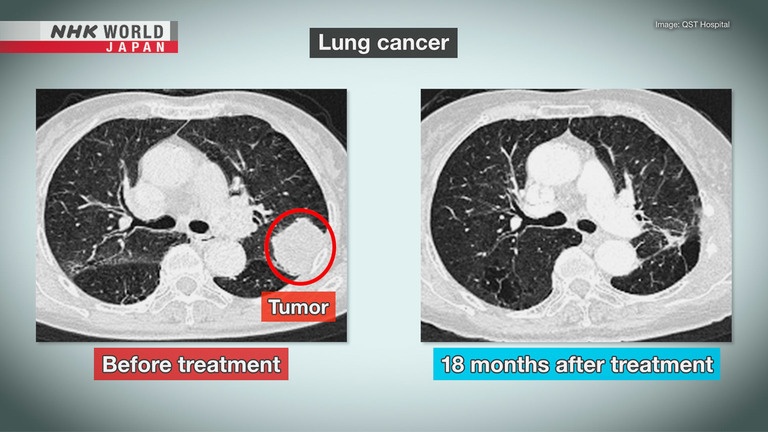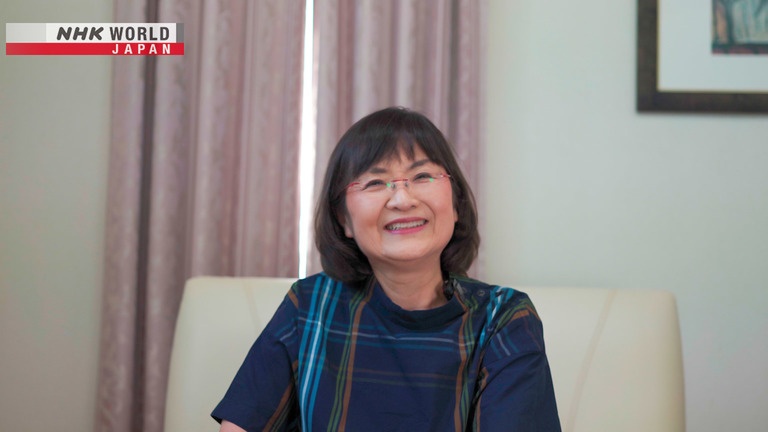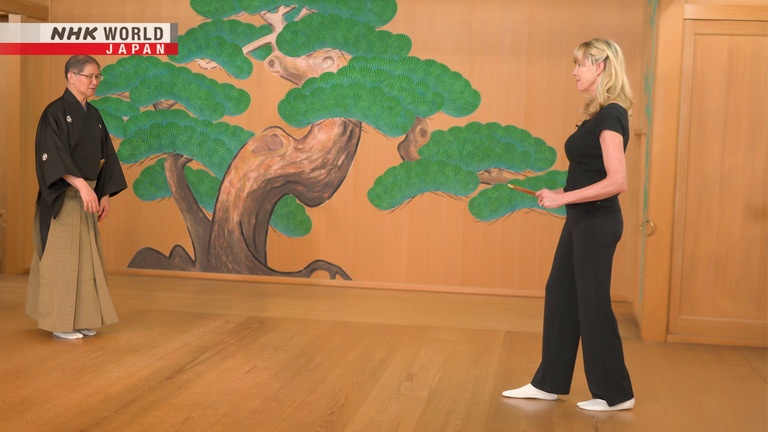New Horizon in Cancer Care: Heavy Ion Radiotherapy
Conventional radiotherapy commonly uses X-rays, which have limited reach and can harm surrounding normal cells. Heavy ion radiotherapy, a promising alternative, uses heavy ion beams to effectively treat deep-seated cancers such as those of the pancreas and liver. Japan's leading facility for the therapy attracts trainees worldwide. We highlight the latest research on heavy ion radiotherapy, featuring a case study of pancreatic cancer which has been in remission for eight years.




Transcript
Join us as we explore Medical Frontiers.
Although we can't see or touch them, different types of radiation are constantly raining down on us from outer space.
One type is known as heavy ion beams.
Although heavy ion beams have little effect on the human body in daily life,
Japanese doctors have made great strides in using them in cancer treatment.
Heavy ion radiotherapy has been found to be more effective and have fewer side effects than conventional radiation therapy.
In this program, we will explore the forefront of research on this treatment.
QST hospital achieved a milestone as the world's first institution to successfully implement heavy ion radiotherapy.
The national hospital specializes in radiation medicine, and has treated over 15,000 patients in the past 30 years.
In this colorectal cancer case, the tumor has partially eroded the pelvic bones.
Heavy ion beams were applied to the area.
The tumor disappeared 12 months after the treatment.
The pelvic bones are showing signs of regeneration.
In a lung cancer case, heavy ion beams were directed at the tumor in the right lung.
18 months after treatment began, the tumor vanished.
We spoke to the director of QST hospital on the latest findings and the potential of heavy ion radiotherapy.
What are some of the advantages of carbon ion, heavy carbon ion radiotherapy compared to other methods?
It puts less burden on patients, recovery is
quicker, and it can be completed in a shorter time.
It's an outpatient procedure, so patients can
maintain their daily lives while receiving treatment.
Radiation is the flow of energy in our surroundings, including sunlight and radio waves from Wi-Fi.
Two types of are used in cancer treatment: light and particle radiation.
X-rays, considered the gold standard for radiotherapy, fall into the former category.
The latter involves streams of microparticles, such as atomic nuclei.
Radiotherapy utilizes proton beams, composed of hydrogen nuclei, and heavy ion beams, consisting of heavier carbon nuclei.
X-rays deliver maximum radiation near the body's surface, damaging normal cells in the area.
Their effectiveness decreases in deeper regions.
In addition, because X-rays are a form of light, they tend to scatter easily,
damaging healthy cells lateral to the cancer cells.
On the other hand, heavy ion beams can reach cancer cells deep within the body,
delivering the maximum radiation dose where it is needed.
Because heavy ion beams are heavy and highly destructive,
they can cause severe damage to cancer cells, while minimizing harm to healthy cells.
However, a drawback of heavy ion radiotherapy is the need for large facility,
roughly the size of a soccer field, to generate these beams.
Using electric force, this facility accelerates carbon nuclei and transforms them into high-energy beams.
The facility at QST Hospital stands out for its ability to accelerate the particles to speeds of up to 1 million rotation per second,
or about 70 percent of the speed of light.
The accelerated heavy ion beams are then directed at cancer cells from various angles.
What are the types of cancer are best suited for heavy ion radiotherapy?
Cancers that are located deep in the body and
remain localized are best suited for this therapy.
They include pancreatic, liver,
esophageal, lung and prostate cancer.
Head and neck cancers and bone cancer are also suitable candidates.
In total, over 10 types of cancer can be effectively treated.
The method is attracting attention as a therapeutic option for pancreatic cancer,
which is notoriously difficult to treat.
Pancreatic cancer causes few observable symptoms, making early detection difficult.
Surgery is challenging because of the proximity of the pancreas to other organs.
The 5-year survival rate for pancreatic cancer is just 8.5 percent -
significantly lower than those for colorectal, stomach and lung cancers.
Heavy ion radiotherapy saved the life of a patient who had late-stage pancreatic cancer.
In 2015, Iwao Masako, who was 57 at the time, suddenly experienced intense pain in her back.
I had a normal appetite,
so it was completely out of blue.
In fact, I was taking jazz dance lessons
up until the week before.
During a medical examination, a 5.5 centimeter-tumor was found in her pancreas, revealing stage-three cancer.
The tumor was entangled with blood vessels, making surgical removal impossible.
I panicked as thoughts of my 2 kids
with disabilities filled my mind.
I worried about the difficulties they might
face if I were no longer there for them.
Iwao lives with her husband and three sons.
Two of her sons use wheelchairs due to immunodeficiency diseases.
I had always assumed that I'd have to keep
looking after them until I reached around 80.
I asked myself whether it was acceptable
to leave them at such an early stage.
Iwao began receiving chemotherapy.
It led to various side effects, including hair loss, dizziness, and numbness in her limbs.
While searching every day for alternative treatment methods, her husband, Takehiro, came across heavy ion radiotherapy.
I had assumed her prognosis was unfavorable.
But I believed that if she opted for heavy ion
radiotherapy, a positive outcome was still possible.
Iwao decided to pursue heavy ion radiotherapy.
She had her first session in 2016.
Doctors generated these images to devise her treatment plan.
They depict the tumor's location, beam angles and radiation doses.
Based on this plan, Iwao received four sessions a week for three weeks.
It was almost like undergoing a CT scan or X-ray.
I felt no sensations during the sessions.
There was no discomfort.
She continued with her chemotherapy after the treatment.
A year later, an examination revealed that her tumor had shrunk.
Two years later, she received the news of a "complete response," indicating the absence of cancer cells in her body.
I was happy to hear the news. I felt relieved.
Shinoto Makoto, who treated Iwao at the time, decided to pursue heavy ion radiotherapy
for her seemingly inoperable pancreatic cancer based on several factors.
Images provided by Iwao at her first visit showed
that the tumor was entangled with blood vessels.
But blood vessels don't pose any significant
challenges for heavy ion radiotherapy.
In cases such as Iwao's, where the tumor is entangled with blood vessels,
surgical removal is not possible due to the risk of damaging them.
However, blood vessels have a certain level of resistance to radiation.
This is why Iwao's tumor was treatable with heavy ion radiotherapy.
Heavy ion therapy is a good solution
for tumors deemed inoperable.
In Iwao's case, the tumor itself responded
very well to heavy ion therapy.
Also, there was no metastasis, although it
may have disappeared due to chemotherapy.
By meeting both of these criteria, we were
able to achieve a favorable outcome.
However, such cases are rare.
This is because pancreatic cancer is
known as a challenging disease to treat.
In terms of carbon ion radiotherapy, what are the limitations in terms of affected areas?
Most important is whether we can avoid
the digestive tract, which is sensitive to radiation.
This therapy cannot be used on cancer
that has infiltrated the digestive tract.
Also, it is designed for localized cancer.
It is not suitable for distant metastases.
Pancreatic cancer is often diagnosed at very late stages.
And I think time is the essence.
So why isn't it available first step?
Currently, chemotherapy is always the first step
for pancreatic cancer patients in all stages.
Chemotherapy can control unseen metastases
and stabilize patients' conditions.
It can even shrink tumors, creating
favorable conditions for heavy ion radiotherapy.
Therefore, heavy ion radiotherapy doesn't
necessarily have to be the first step.
It can be incorporated at the most optimal timing.
That's the best way to construct a treatment plan.
Iwao has remained cancer-free for eight years after her heavy ion radiotherapy.
Her life is gradually returning to the way it was before her cancer diagnosis.
As the years go by, I'm amazed
by the fact that I'm still alive.
Thoughts of cancer used to consume my mind,
but these days, I think about it less and less.
Still, it comes back to me at least once a day.
Now, I just follow general guidelines
for maintaining good health.
They include avoiding overeating and fatigue.
Heavy ion radiotherapy is currently available at 14 facilities worldwide.
Seven of them are located in Japan.
QST Hospital welcomes from patients from abroad who are seeking the treatment.
The therapy costs over 5 million yen, or approximately 35,000 dollars, when not covered by Japan's national health insurance.
The main reason for the high cost is the huge
equipment required, including the accelerator.
In 2017, we launched the Quantum Scalpel
project to address this issue.
The project aims to minimize the equipment needed for the treatment.
The current system includes a massive accelerator and occupies an area the size of a soccer field.
It incurs substantial expenses for construction and maintenance.
The new system has significantly smaller components and fits within the space of a volleyball court.
It can easily be integrated into existing hospitals.
Construction of the new system has already begun at QST Hospital with the goal of putting it into practical use at the end of 2026.
Construction and maintenance costs will plummet.
This will pave the way for facilities across
the world to introduce the system.
We expect that heavy ion radiotherapy will become
as affordable as conventional radiotherapy.
QST Hospital has also been welcoming healthcare professionals from overseas to learn and train in heavy ion radiotherapy.
To date, over 250 people from 20 countries and regions have participated in the program.
Hello, I am Kang Hyun-Cheol from
Seoul National University Hospital.
Seoul National University Hospital in South Korea decided to introduce heavy ion radiotherapy in 2020.
It signed a contract with a Japanese manufacturer and is in the process of installing the equipment.
Cancer patients in South Korea are surging
as the population rapidly ages, similar to Japan.
Heavy ion radiotherapy is widely known
in our country as an effective treatment
for difficult-to-treat cancers.
Many South Koreans are keen to receive it.
It's new in our country, so I'd like to share the
experiences and know-how I acquired in Japan.
Many healthcare professionals are also visiting QST Hospital from Taiwan.
Hello, I'm Kang Yu-Mei from
the Taipei Veterans General Hospital.
We had a case of a young lady with a
salivary gland cell tumor at the base of her tongue.
With surgery, partial removal of her face
would have been necessary.
She was reluctant about this procedure because
it could impair her ability to speak and eat.
We sent her to Japan for heavy ion radiotherapy.
Kang studied heavy ion radiotherapy at QST hospital for a year from 2020.
In May 2023, Taiwan's first heavy ion radiotherapy facility was established.
As a member of the staff, she is now sharing the knowledge and experiences she acquired in Japan.
We have extensive experience to share
with global healthcare professionals.
It's not enough to simply provide machines.
Heavy ion radiotherapy requires very different
techniques from conventional radiotherapy,
so we must also foster experts.
I believe our mission is to welcome as many
healthcare professionals as possible.
In the United States, construction has begun for its first heavy ion radiotherapy facility.
Hi, my name is Brad Hoppe.
I'm a professor of Radiation Oncology at the Mayo Clinic in Florida.
The Mayo Clinic, one of the top medical institutions in the US, is building a heavy ion radiotherapy facility, scheduled to open in 2027.
We have a lot to learn from the Japanese centers that have been doing carbon ion therapy a lot longer than obviously we have.
We're also working with other centers,
Osaka and Yamagata Carbon ion centers in which we're sending our physicists over to gain some training.
And we hope in the future to be able to send our physicians abroad to gain some training in treating patients with Carbon ion therapy as well.
Studies are also underway in Japan to use heavy ion radiotherapy on diseases other than cancer, such as arrhythmia.
Researchers are working to expand its scope and potential.
Human life of just 50 years is fleeting
compared with...
Noh is a traditional Japanese theater art characterized by slow movements.
It brings historical events and stories to life through songs called "utai" and dance.
In today's Tips for Healthy Living, we will explore the unique movements of Noh through exercises designed by Noh performer Yasuda Noboru.
Mr. Yasuda, thank you so much for coming on the program.
It's my pleasure.
How did you come up with the exercises behind Noh?
What amazed me about Noh is that the performers
continue beyond age 90 as if it were the norm.
I came to realize that the unique walking style
in Noh called "suri-ashi," or sliding feet,
strengthens the deep muscles. This could be
the key to staying energetic, even in old age.
Suri-ashi is a technique used in Noh that enables performers to move silently on the stage.
They slide their feet without lifting their heels off the floor.
Suri-ashi involves the use of the psoas major muscle, which connects the backbone and the thigh bone.
It plays a crucial role in balancing the upper body and lower body.
Most people misuse the psoas, relying on
the muscles in the front of their legs out of habit.
To learn how to walk without using these muscles,
let's try moving our feet without exerting force.
Prepare a platform about 10 centimeters tall.
Stand on it with one foot and maintain an upright posture, using a wall or someone's shoulder for support if needed.
Swing your other foot back and forth slowly.
Move your foot without exerting force.
Remember this movement, because
you will use it later for suri-ashi.
Feel how it gradually elongates your psoas muscle.
It's a muscle that I don't think I use in daily life.
Step off the platform and try walking.
Doesn't your right leg seem longer?
This feels longer.
Actually, my leg feels longer.
Just from that small exercise.
Repeat on the other side.
Swing your foot slowly, about 30 times per minute.
Now that you've worked on both sides, you're ready to try suri-ashi.
Let me show you how suri-ashi is done.
Imagine pulling your foot up from the psoas and slide it forward.
Keep your heels on the floor and your thigh muscles relaxed.
As you walk, gaze into the distance
and pull your chin back slightly.
Walk while recalling the swinging of your legs.
Keep your heel on the floor as much as possible.
Make sure your step is no larger than
the length of your foot. Relax your thighs.
Yes, that's right.
So interesting because I think if you look at whether it be pilates or yoga or aerobics, all of these things,
we're so used to activating our muscles and not relaxing our muscles.
To engage deep muscles such as the psoas, small and slow movements are effective.
Next is an upper body exercise called "sashi."
It's a typical Noh movement which uses a fan or a hand to point forward.
The deep muscles it targets are the rhomboids, located behind the shoulders.
These muscles connect the shoulder blades to the upper-arm bones and help maintain a proper posture.
Let's start with the proper stance.
Stand with your feet shoulder-width apart and relax your knees.
Extend your arms in front of you and form a circle.
Bring them toward yourself, stopping in front of your hips.
You're ready to start the sashi movement.
Bring your left foot back while extending your right arm to the side.
Then, step back with your right foot while moving your right arm forward.
Relax your arms and focus on controlling your arm using the back of your shoulder.
Noh moves are always bidirectional.
When moving forward,
the focus is on the back.
When moving backward,
attention should be on the front.
Let's start. Bring your left foot back
and spread your right arm.
Pay attention to the rhomboids when
moving your right hand forward.
Move slowly to ensure you're activating the rhomboids.
Because I think the thing is also we tend to use the biceps, the triceps, and not so much the rhomboid.
It's so different to how we generally move.
In Noh, the emphasis is on the ability to relax
the muscles rather than strengthen them.
That's why Noh actors can continue
to perform even after they turn 90.
Thank you.
I felt so clumsy doing Noh.